
Corridor Implementation
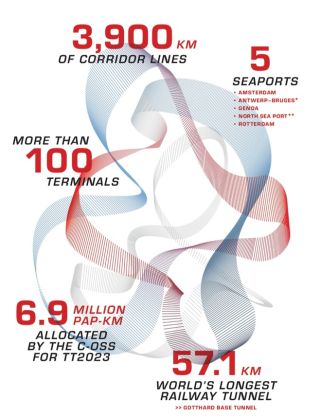
The Rail Freight Corridors (RFCs) have been established to strengthen Europe-wide rail freight transport by lowering barriers at borders, improving performance quality and cooperation in the rail sector as well as the development of a network, that offers sufficient capacity and harmonised processes. All this shall support the modal shift from road to rail to meet the targets of the transport and environmental policy, like e. g. decarbonization.
The Rail Freight Corridor Rhine-Alpine is committed to develop the Corridor in line with the Implementation Plan. In a broader context, both, the Executive Board and Management Board, will continue the cooperation with external partners. Cooperation with Rail Freight Corridor North-Sea-Mediterranean is of critical importance. In addition, the Rail Freight Corridor will continue to invest in cooperation at the European network level, e.g., to foster digitalisation (the ETA projects) and improve reliability (i.a. Rail CDM). All these international cooperation issues are in line with the Berlin declaration of ministers from 2020.
Legally the RFCs are based on the Regulation (EU) 913/2010 which entered into force on 9 November 2010. RFC Rhine-Alpine was officially established on 10 November 2013, when the initial Implementation Plan (IP) was published.
The following information is taken from the Implementation Plan Update, published in December 2023 by the decision of the Executive Board of RFC Rhine-Alpine.
All Annexes to the Implementation Plan can be downloaded here.
The Annexes to the Implementation Plan can be found as single documents under the following links:
- Annex A: 740 m Network
- Annex B: List of Projects
- Annex C: Development of Capacity Bottlenecks
- Annex D: Graphical Overview of ERTMS development
- Annex E: Management and Backwards compatibility analysis (ERTMS)
- Annex F: Opinion of the Railway undertaking Advisory Group
Key topics on RFC Rhine-Alpine
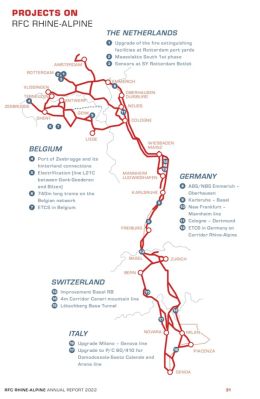
In Art. 11, §1(a) of the Regulation (EU) 913/2010 it is requested that the investment plan includes a “list of projects foreseen for the extension, renewal or redeployment of railway infrastructure”. The latest version of the RFC Rhine-Alpine list of projects is attached in Annex B.
The status of the decision-making on a project is a crucial element in the evaluation of potential future capacity bottlenecks. The decision-making processes on planning approval, building license and financing are different from country to country. But using the available information on RFC Rhine-Alpine 5 stages are distinguished in decision-making:
| How far is the decision making on a project | Meaning |
| Realised | Project has been completed / operational. |
| Realisation | All necessary decisions are taken and money is available. The necessary funds are in place. The building process is ready to start or has already started. |
| Secured (S) | All necessary decisions are taken and money is available and the necessary funds are in place. |
| Planned (P) | First decisions are taken and financial reservations are planned. |
| Study / To Be Decided (TBD) | Solutions how to solve problems are known, but no formal decisions are taken yet and financial funds are not yet known. |
For all the projects, the decision status is mentioned in the list of projects in Annex B. The projects with the ‘Realised’ status are left out of the list. Also the funding source, including EU co-financing, when applicable, is shown.
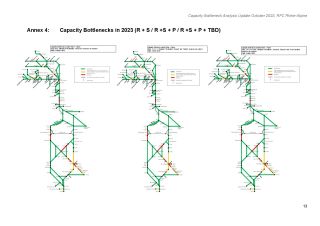
Capacity bottlenecks on the railway infrastructure are monitored. National calculation methodologies at IMs and national decision processes on infrastructure development are different and a common bottleneck analysis for RFC Rhine-Alpine turned out to be a challenging task. Therefore, in 2020, the Management board decided to draw up the Capacity Bottleneck Analysis (CBA) based on the national investment plans to identify the infrastructural bottlenecks. This is a joint corridor approach, consisting of a combination of the national information provided by the different IMs. The CBA in the present Implementation plan contains an update of the infrastructural bottlenecks.
Chapter 6.1 Capacity Management Plan (with a referral to Annex C) shows the latest CBA updated in 2023. It shows the current state of play in 2023 and the scenarios for development in the years 2025 and 2030, based on the national forecasts.
According to the Commission Implementing Regulation (EU) 2177/2017, rail service facility operators such as terminal operators have the legal obligation to publicly provide detailed information on their infrastructure and services. A possible way to be compliant with this regulation is to provide the required information using the Rail Facilities Portal. RNE and RFC Rhine-Alpine support the use of the Rail Facilities Portal as joint source.
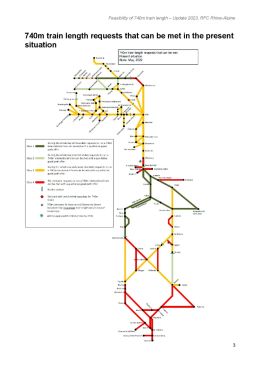
Regulation (EU) 913/2010 – Article 9 (1.a) also requests a description of the characteristics of the freight corridor. RFC Rhine-Alpine uses CIP to inform about the following line properties:
- Line category (Load model)
- Traction Power
- Signalling Groups
- Intermodal Freight Code
- Gauging
- Gradient
- Number of tracks
In CIP, this information is given on the map. The user can select the different categories to see the applicable values on the whole corridor but also on single line sections.
Further information on the evolution of 740 m trains on RFC Rhine-Alpine can be found in Annex A to the Implementation Plan.
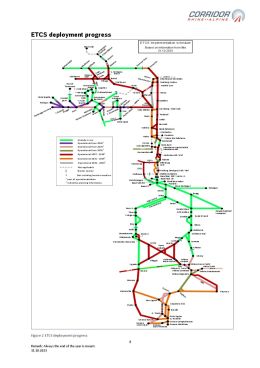
In order to keep up with the progress of digitalisation and growing traffic demand, the establishment of interoperability through a common European train control system is a paramount prerequisite. Subsequently, the implementation of ERTMS is part of the European policy.
The following chapter describes the ERTMS Deployment plan of RFC Rhine-Alpine (status 31.10.2023), according to Art. 11, 1(b) of the Regulation (EU) 913/2010. Legally the deployment by the Member States along RFC Rhine-Alpine is still based on the currently applicable European Deployment Plan for the European Rail Traffic Management System which is included in the Commission Implementing Regulation (EU) 2017/6 of 5 January 2017. This Regulation is expected to be updated in 2024.
In addition to the EDP, on 14 November 2017 the EU Commission published a working document on actions and associated objectives to achieve interoperability and drive ERTMS deployment (Delivering an effective and interoperable European Rail Traffic Management System (ERTMS – the way ahead)) also known as ERTMS Deployment Action Plan. It specifies that both, the CNC and RFC, which have as their constituent members certain of the addressed stakeholder groups (Ministries, NSAs and Infrastructure Managers), should also be used effectively to support ERTMS deployment.
Graphical overviews and maps on the state of play of ERTMS deployment planning are provided in Annex D to the Implementation Plan. The corridor sections as well as some subsequent sections of adjacent corridors are shown with their planned completion dates, ETCS deployment type, ETCS system version, the planned development of the radio systems, the expected availability of class B/A-systems and an overview on the border crossings.
Selected information on ERTMS deployment is also available on the map in CIP in the area ETCS Deployment on the bottom of the left-hand side of the screen and in the information documents area (link). In the period until the next update of the ERTMS Deployment Overview the database in CIP will regularly be updated.
We present the cookies we use and can use under the link Cookie settings in the privacy policy. Only permissible cookies for which we do not require your consent are preset. You can agree to further functional cookies separately in the cookie settings or by confirming the "Accept" button.
